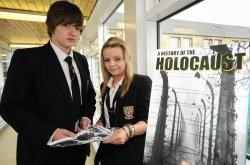Through the gates of hell
Register for free to read more of the latest local news. It's easy and will only take a moment.
EMOTIONAL MORAY teenager Bethany Hay admitted she felt guilty after a visit to the former Nazi concentration camp Auschwitz-Birkenau.
Guilty, because she was able to walk back out through the gates and home to her family.
Bethany (17) admitted she was overwhelmed at the thought that 1.2 million people never made it out of the camp alive during World War Two.
The Buckie High School pupil and fellow sixth year Michael Rennie (16) were among 235 pupils from all over Scotland to visit the Birkenau death camp in Poland – one of six in the country – last week.
Their visit was part of the ‘Lessons from Auschwitz Project’ run by The Holocaust Educational Trust.
Both admitted the visit had a big impact on them.
"It was a lot worse than I expected," said Michael, who said standing in one of the former gas chambers was the moist poignant part of the trip.
"When the doors were shut, which were the only source of light, there was real tension," he said.
Added Bethany: "You could see up to the roof where they poured the gas. It was awful, I could just see the folk standing there."
Although the name Auschwitz has become synonymous with the Holocaust, the Polish town was known as Oswiecim before occupation by the German forces who installed a Nazi town council and mayor and renamed it Auschwitz.
Before the war, the town’s population was 58% Jewish but now none of its 40,000 inhabitants are Jewish.
SS leader Heinrich Himmler, architect of the Holocaust, ordered that a concentration camp be created at Auschwitz, with 300 local Jews used to convert the former Polish Army barracks.
Many locals were forced out of their homes during the war by an exclusion zone that surrounded the camp. Villagers in nearby Brzezinka were evicted to pave the way for an Auschwitz II (Birknenau).
Bethany and Michael said books and films on the holocaust cannot compare to being there and do not really prepare you for the experience.
"It is difficult to explain without seeing it. It has affected me more than I thought it would," said Bethany.
Michael said: "It makes you realise that these things are still happening in the world and we have to stop them."
He pointed to the Sudanese region of Darfur, where an estimated 400,000 people have died through genocide and fighting, and the current troubles in Libya.
The pupils were addressed by Holocaust survivor Zigi Shipper which brought the experience even more to life.
They toured the Auschwitz-Birkenau Museum, which still has many items of clothing, shoes and personal effects belonging to those who died there.
The first prisoners started arriving at Auschwitz by the end of 1940, and they were tatooed and photographed on arrival.
However, as time went by, fewer photographs were taken and those destined to die on arrival were never recorded at all.
The second camp at Auschwitz originally held prisoners of war but was later developed to be the main extermination centre.
The gas chambers were made to look as ordinary as possible and those being sent there were encouraged to believe they were going for a shower before being admitted to the main camp.
There are no exact figures of those who died at Auschwitz Birkenau, but it is estimated to be around 1.2 million. Before the war Poland had 3.5 million Jews but today the Jewish community is only around 6,000.
Bethany and Michael, who were accompanied by other students from Moray schools, have been invited to do a presentation in Buckie Library and will also address S2 pupils.
Poor weather meant they were unable to light candles in a memorial service at Auschwitz but they hope to light them at a school assembly. They will also attend a seminar this weekend in Edinburgh where all the pupils who went on the trip will discuss their thoughts and feelings.
Donna Mackintosh, principal teacher of guidance, who visited Auschwitz as part of a previous school visit in 2009, said: "Those that have been involved have all been affected massively and it has changed their outlook on life."
She said a generation of youngsters have experienced Auschwitz and can impart that knowledge to others at school and in the local community.
More information on the project is available online at www.het.org.uk










